Contributing € 15
Photo with recipe
With this collaboration you will get a photo of the pasture where we will raise the Buey Ibérico de Bellota with a delicious meat recipe.
> 08 Co-financiers
We use own and third party cookies to improve your user experience and our services, analyzing users' browsing in our website. If you continue browsing, we will consider that you consent to its use. You can get further information in our Cookies Policy
(Acorn-fed Iberian Ox)
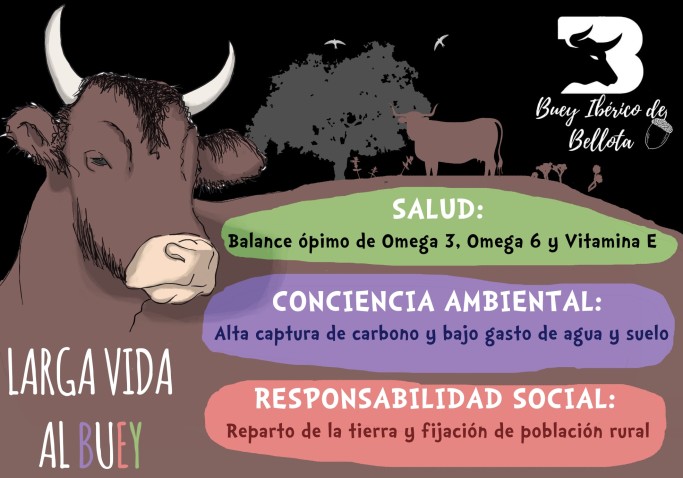

 Min.
Min.
 Opt.
Opt.
With this collaboration you will get a photo of the pasture where we will raise the Buey Ibérico de Bellota with a delicious meat recipe.
Visit one of the 3 farms participating in the project to find out how we work the land and care for our animals. You will be able to learn all the details of the livestock management of the Iberian Acorn-fed Acorn-fed Beef, how this project helps to fight against climate change, the excellent animal welfare, the biodiversity improvement actions we carry out, etc.
One morning session in a small bird photographic hide (“blind” in U.S. English) where you will be able to photograph a lot of species. Depending on the time of year, this hide is frequented by blue tits, chickadees, goldfinches, hoopoes, orioles, jays, yellowhammers, sparrows, pied flycatchers, grey flycatchers, willow warblers, robins, blackcaps, blackbirds, thrushes, greenfinches, green woodpeckers, woodpeckers, nuthatches, redstarts, chaffinches and many more...
3 hour session
At the time of MONTANERA (acorn fall) we will make a collective visit to get to know the pasture (dehesa) where the oxen are, making VAREO DE BELLOTAS (beating the branches) where the cows and oxen will come to eat the precious treasure. There you can ask us anything you want to know about the animals we breed. We will talk about nature, livestock and climate change and anything else that comes up.
As a walk through the pasture will whet your appetite, there is nothing better than ending the day with a delicious stew made with meat from our farms.
The most appropriate date for the visit will be during the "montanera" (November-December).
Approximate duration: 3 hours
At the time of MONTANERA (acorn fall) we will make a collective visit to know the pasture where the oxen are, making VAREO DE BELLOTAS where the cows and oxen will come to eat the precious treasure. There you can ask us anything you want to know about the animals we breed. We will talk about nature, livestock and climate change and anything else that comes up. As a walk through the pasture will whet your appetite, there is nothing better than ending the day with a delicious stew made with meat from our farms. The most appropriate date for the visit will be during the "montanera" (November-December).
Approximate duration: 3 hours
One morning session in a small bird photography hide where you will be able to photograph a lot of species. Depending on the time of year, this hide is frequented by blue tits, chickadees, goldfinches, hoopoes, orioles, jays, yellowhammers, sparrows, pied flycatchers, grey flycatchers, willow warblers, robins, blackcaps, blackbirds, thrushes, greenfinches, green woodpeckers, woodpeckers, nuthatches, redstarts, chaffinches and a long etc.
3 hour session
With this reward you will also get a photo of the pasture where we will breed the Iberian Acorn-fed Beef with a delicious meat recipe.
Pack of meat. 6 kg.
At the time of MONTANERA (acorn fall) we will make a collective visit to know the pasture where the oxen are, making VAREO DE BELLOTAS where the cows and oxen will come to eat the precious treasure. There you can ask us anything you want to know about the animals we breed. We will talk about nature, livestock and climate change and anything else that comes up. As a walk through the pasture will whet your appetite, there is nothing better than ending the day with a delicious stew made with meat from our farms. The most appropriate date for the visit will be during the "montanera" (November-December).
Approximate duration: 3 hours
One morning session in a small bird photography hide where you will be able to photograph a lot of species. Depending on the time of year, this hide is frequented by blue tits, chickadees, goldfinches, hoopoes, orioles, jays, yellowhammers, sparrows, pied flycatchers, grey flycatchers, willow warblers, robins, blackcaps, blackbirds, thrushes, greenfinches, green woodpeckers, woodpeckers, nuthatches, redstarts, chaffinches and a long etc.
3 hour session
Agroecological beef produced in the Fields of Extremadura, taking advantage of the ACORN.
 Material
Material
|
Minimum | Optimum |
|---|---|---|
|
4 GRAZING CATTLE (1 to 3 years old)
Slaughtered at a minimum age of 4 years
|
€ 7.500 | |
|
● 6 SUCKLER COWS
Grazing-fed cows
|
€ 6.000 |
 Task
Task
|
Minimum | Optimum |
|---|---|---|
|
Goteo's service and transaction fees.
These will be the costs arising from the crowdfunding process that we will pay to Goteo and also some financial costs related to the crowdfunding process.
|
€ 500 | |
| Total | € 8.000 | € 14.000 |
Description
Our project deals with the breeding and fattening of agroecological cattle using autochthonous breeds, fed exclusively with products from the pasturage called dehesa (grass, browsing, and acorns), obtaining meat of excellent quality, both organoleptic and environmental, the latter aspect being very necessary for the transformation of livestock from an agent of climate change to a tool against global warming.
Acorn-fed Iberian Ox is a concept that brings together three ideal features of food production: nutritional quality, the defence of nature, and the fight against rural depopulation:
Buey Ibérico de Bellota combines the best management of cattle, the best choice of low-impact breeds and the best organoleptic quality, all taking into account a receding environment.
Objectives
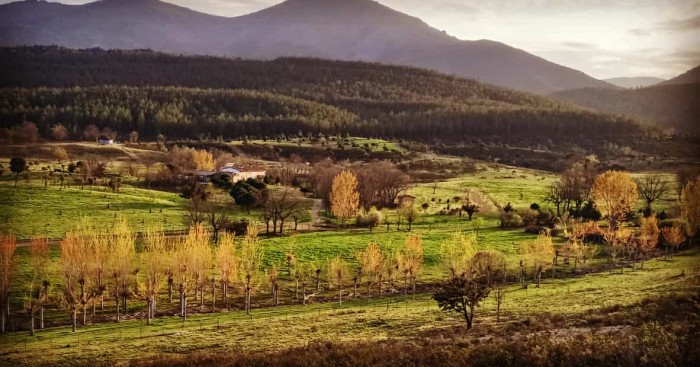
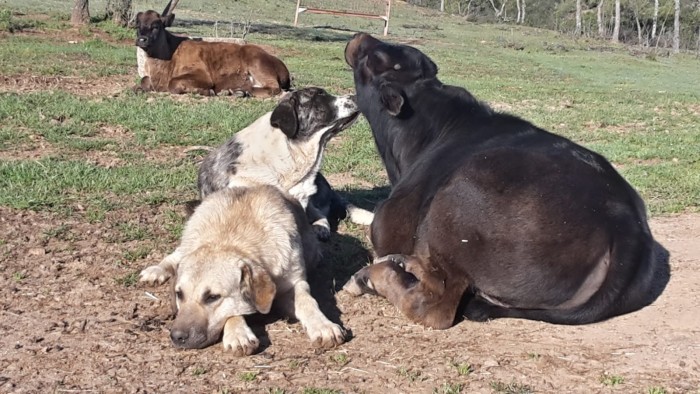
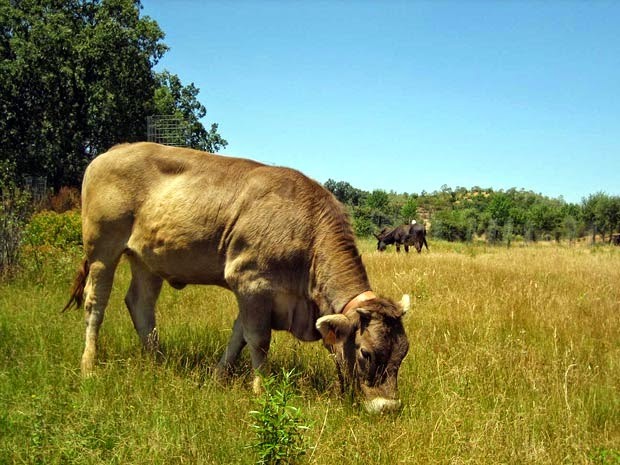
Motivation and Goal of the Project
Global meat production is largely based on intensive models that separate animals from their natural environment. This method repeats the industrial pattern of materialistic and commercial use of raw materials. In this way, meat becomes an object of buying-selling, rather than the provision of food.
Our interest with this project is to return the sensible production of food to the community, in which the main engine is not to obtain profits at all costs, but rather the closing of cycles, animal welfare, the dignity of the agrarian profession, the protection of agro-systems such as the dehesa and the right to fair, non-elitist food, thus implying that quality food is a universal right.
We choose to raise oxen because these animals take ten years or more to yield.. This delay implies that the animal leaves its phase of consuming animal protein and becomes a net consumer of cellulose, a food that cannot be processed by humans. We thus find an intelligent natural way to transform a material that is unusable for us.
Energy efficiency is proportional to carbon fixation as the animal ages:
On the other hand, the ox is not subjected to the stressful and crowded conditions of a feedlot and would enjoy the freedom of living in the countryside.
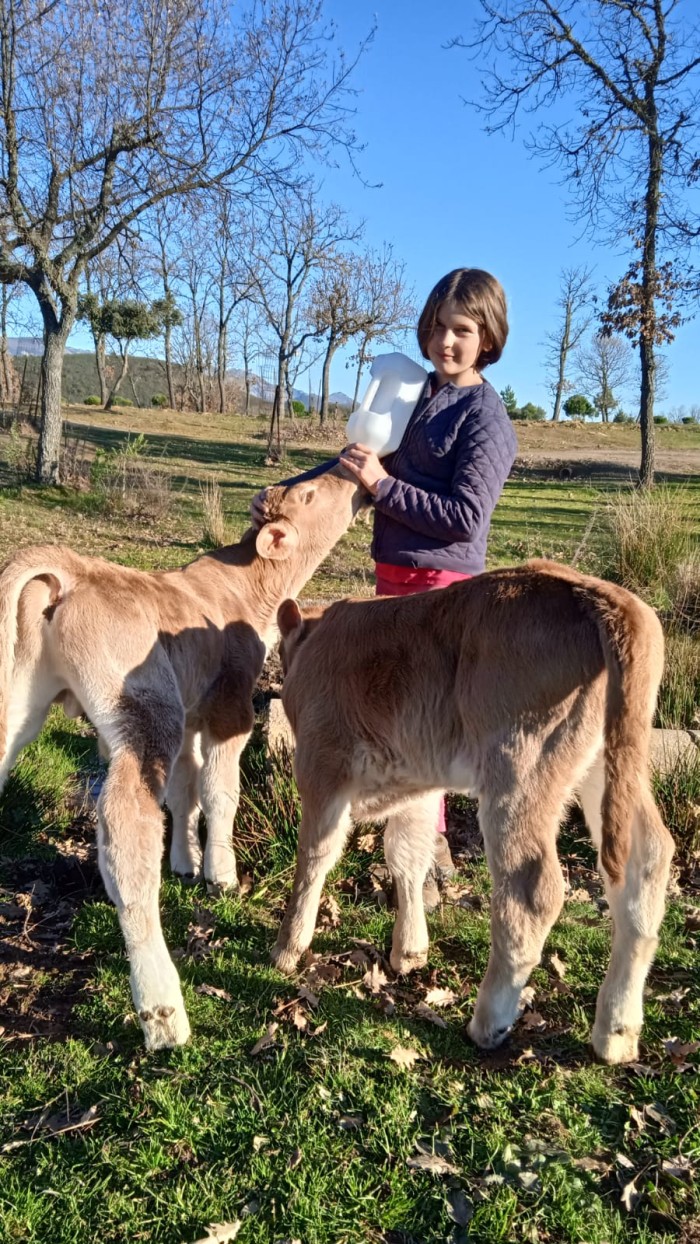
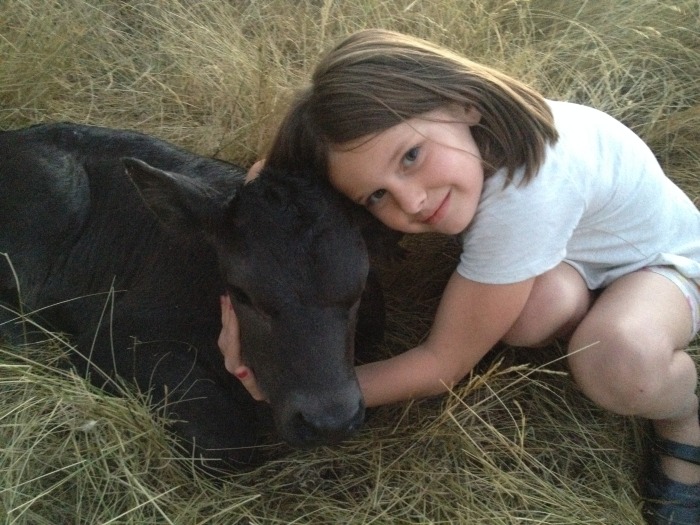
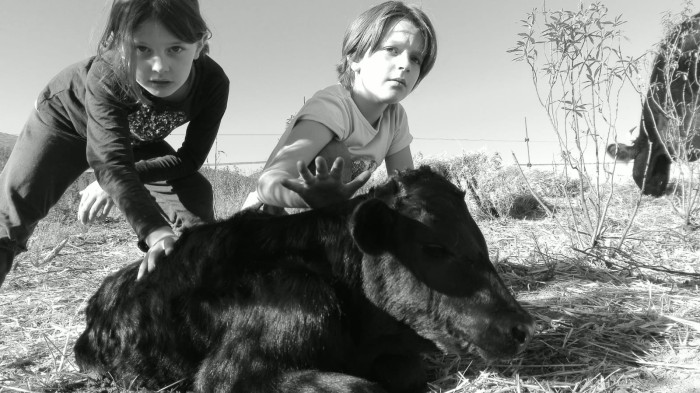
Buey Ibérico de Bellota is made up of three families who share a common way of life; living on agro-ecological farms in the middle of the countryside, where we raise cows, goats, sheep, grow vegetables and fruit, sell our products directly to responsible consumers who are concerned about animal welfare and sustainability, food sovereignty, environmental education, ecotourism, etc.
The families in this project are Carmen, Mario and Andrés from El Rincón de los Cerezos; Gloria, Alberto and Juan from Huecos del Arroyo; and Gema, Pepe, Catalina and Pepa from Las Lucías, all in the province of Cáceres.
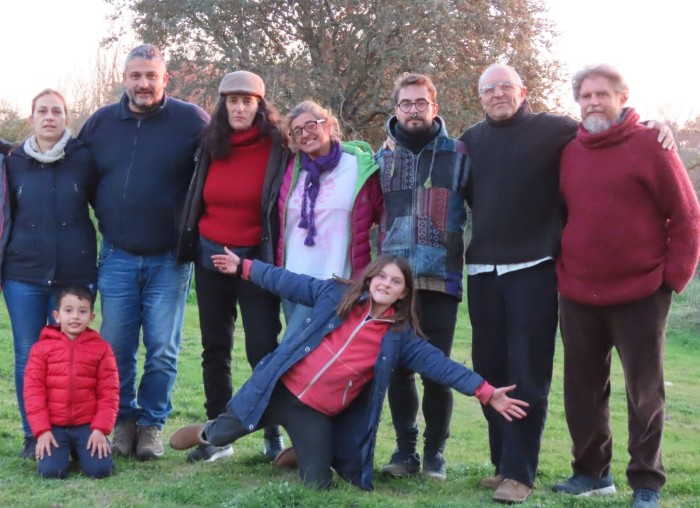
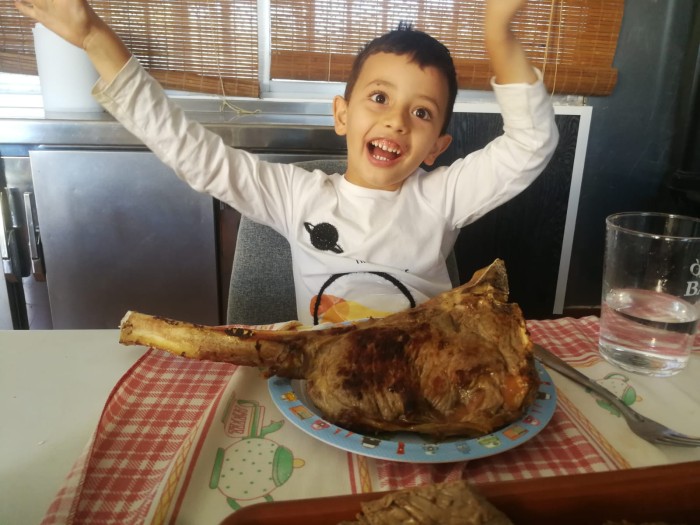

● Demonstrate that beef production under appropriate conditions and criteria provides a product of verifiable environmental viability.
● Make visible that the consumption of lactating or early-aged animals is wrong from an energetic, ethical and economic point of view
● Raise the profile of the agro-environmental importance of the Extremaduran dehesa
Photo with recipe
With this collaboration you will get a photo of the pasture where we will raise the Buey Ibérico de Bellota with a delicious meat recipe.
> 08 Co-financiers
Guided tour of one of the 3 farms
Visit one of the 3 farms participating in the project to find out how we work the land and care for our animals. You will be able to learn all the details of the livestock management of the Iberian Acorn-fed Acorn-fed Beef, how this project helps to fight against climate change, the excellent animal welfare, the biodiversity improvement actions we carry out, etc.
> 08 Co-financiers
Photographic Hide
One morning session in a small bird photographic hide (“blind” in U.S. English) where you will be able to photograph a lot of species. Depending on the time of year, this hide is frequented by blue tits, chickadees, goldfinches, hoopoes, orioles, jays, yellowhammers, sparrows, pied flycatchers, grey flycatchers, willow warblers, robins, blackcaps, blackbirds, thrushes, greenfinches, green woodpeckers, woodpeckers, nuthatches, redstarts, chaffinches and many more...
3 hour session
> 04 Co-financiers
DEHESA FIESTA
At the time of MONTANERA (acorn fall) we will make a collective visit to get to know the pasture (dehesa) where the oxen are, making VAREO DE BELLOTAS (beating the branches) where the cows and oxen will come to eat the precious treasure. There you can ask us anything you want to know about the animals we breed. We will talk about nature, livestock and climate change and anything else that comes up.
As a walk through the pasture will whet your appetite, there is nothing better than ending the day with a delicious stew made with meat from our farms.
The most appropriate date for the visit will be during the "montanera" (November-December).
Approximate duration: 3 hours
> 30 Co-financiers
DEHESA FIESTA WITH CALDERETA + PHOTO SESSION IN HIDE FOR TWO PEOPLE + DEDICATED PHOTO WITH RECIPE
At the time of MONTANERA (acorn fall) we will make a collective visit to know the pasture where the oxen are, making VAREO DE BELLOTAS where the cows and oxen will come to eat the precious treasure. There you can ask us anything you want to know about the animals we breed. We will talk about nature, livestock and climate change and anything else that comes up. As a walk through the pasture will whet your appetite, there is nothing better than ending the day with a delicious stew made with meat from our farms. The most appropriate date for the visit will be during the "montanera" (November-December).
Approximate duration: 3 hours
One morning session in a small bird photography hide where you will be able to photograph a lot of species. Depending on the time of year, this hide is frequented by blue tits, chickadees, goldfinches, hoopoes, orioles, jays, yellowhammers, sparrows, pied flycatchers, grey flycatchers, willow warblers, robins, blackcaps, blackbirds, thrushes, greenfinches, green woodpeckers, woodpeckers, nuthatches, redstarts, chaffinches and a long etc.
3 hour session
With this reward you will also get a photo of the pasture where we will breed the Iberian Acorn-fed Beef with a delicious meat recipe.
> 07 Co-financiers
Pack of meat. 6 kg.
Pack of meat. 6 kg.
> 12 Co-financiers
CORPORATE PACKAGE FOR A MAXIMUM OF 10 PEOPLE
At the time of MONTANERA (acorn fall) we will make a collective visit to know the pasture where the oxen are, making VAREO DE BELLOTAS where the cows and oxen will come to eat the precious treasure. There you can ask us anything you want to know about the animals we breed. We will talk about nature, livestock and climate change and anything else that comes up. As a walk through the pasture will whet your appetite, there is nothing better than ending the day with a delicious stew made with meat from our farms. The most appropriate date for the visit will be during the "montanera" (November-December).
Approximate duration: 3 hours
One morning session in a small bird photography hide where you will be able to photograph a lot of species. Depending on the time of year, this hide is frequented by blue tits, chickadees, goldfinches, hoopoes, orioles, jays, yellowhammers, sparrows, pied flycatchers, grey flycatchers, willow warblers, robins, blackcaps, blackbirds, thrushes, greenfinches, green woodpeckers, woodpeckers, nuthatches, redstarts, chaffinches and a long etc.
3 hour session
> 01 Co-financiers